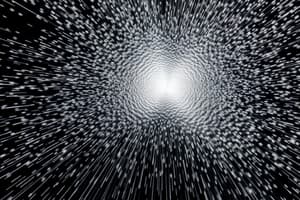Podcast
Questions and Answers
A force is the cause that changes or tends to change the state of rest or motion of a body or changes the shape of an ______.
A force is the cause that changes or tends to change the state of rest or motion of a body or changes the shape of an ______.
object
A force that produces motion in an object is said to have a __________ effect.
A force that produces motion in an object is said to have a __________ effect.
positive
The force exerted by our __________ is known as muscular force.
The force exerted by our __________ is known as muscular force.
muscles
The resistance that opposes the motion of one body over another is called __________ force.
The resistance that opposes the motion of one body over another is called __________ force.
The force that acts between objects that are not in contact is referred to as __________ force.
The force that acts between objects that are not in contact is referred to as __________ force.
The SI unit of force is the __________.
The SI unit of force is the __________.
The force of __________ describes the attraction between objects based on their mass and distance.
The force of __________ describes the attraction between objects based on their mass and distance.
The resultant force is defined as a single force that will produce the same effect as the __________ action of all the forces together.
The resultant force is defined as a single force that will produce the same effect as the __________ action of all the forces together.
Electrostatic force can cause attraction or __________ between particles based on their electric charge.
Electrostatic force can cause attraction or __________ between particles based on their electric charge.
Frictional force opposes relative __________ between two surfaces in contact.
Frictional force opposes relative __________ between two surfaces in contact.
Static friction occurs when a surface attempts to move over another surface in contact and is independent of the area of ______.
Static friction occurs when a surface attempts to move over another surface in contact and is independent of the area of ______.
When a body slides over another body in contact, it experiences ______ friction.
When a body slides over another body in contact, it experiences ______ friction.
The type of friction that occurs when a body rolls over another body in contact is known as ______ friction.
The type of friction that occurs when a body rolls over another body in contact is known as ______ friction.
When an object moves through a fluid, it experiences ______ friction.
When an object moves through a fluid, it experiences ______ friction.
One major effect of friction is that it ______ motion.
One major effect of friction is that it ______ motion.
Friction produces heat and can cause wear and ______.
Friction produces heat and can cause wear and ______.
One way to reduce friction is by using ______.
One way to reduce friction is by using ______.
To increase friction, sports shoes are provided with ______.
To increase friction, sports shoes are provided with ______.
Wear and tear caused by friction leads to the consumption of ______.
Wear and tear caused by friction leads to the consumption of ______.
Corrugated tyres help in increasing ______ between the road and the vehicle.
Corrugated tyres help in increasing ______ between the road and the vehicle.
Static friction is the type of friction that occurs when a body slides over another body in contact.
Static friction is the type of friction that occurs when a body slides over another body in contact.
Fluid friction is generally greater than rolling friction.
Fluid friction is generally greater than rolling friction.
One of the disadvantages of friction is that it can produce significant heat and noise.
One of the disadvantages of friction is that it can produce significant heat and noise.
Polishing surfaces increases friction between them.
Polishing surfaces increases friction between them.
Friction is essential for walking, as it allows us to grip the ground.
Friction is essential for walking, as it allows us to grip the ground.
Tyres are designed to be smooth in order to increase friction on the road.
Tyres are designed to be smooth in order to increase friction on the road.
Wear and tear caused by friction leads to the loss of fuel efficiency.
Wear and tear caused by friction leads to the loss of fuel efficiency.
Using ball bearings is a method of increasing friction between two surfaces.
Using ball bearings is a method of increasing friction between two surfaces.
Spiked sports shoes are designed to reduce friction on the playing surface.
Spiked sports shoes are designed to reduce friction on the playing surface.
The weight of a body affects the amount of friction it experiences.
The weight of a body affects the amount of friction it experiences.
A force can change the direction of motion of an object.
A force can change the direction of motion of an object.
Electrostatic force only produces attraction and never repulsion.
Electrostatic force only produces attraction and never repulsion.
Frictional force does not depend on the materials in contact.
Frictional force does not depend on the materials in contact.
The SI unit of force is Pascal.
The SI unit of force is Pascal.
A force can increase the speed of a moving object.
A force can increase the speed of a moving object.
Mass of a body changes when a force is applied to it.
Mass of a body changes when a force is applied to it.
Mechanical force is the force exerted by machines.
Mechanical force is the force exerted by machines.
The greater the mass of an object, the lesser the gravitational force acting on it.
The greater the mass of an object, the lesser the gravitational force acting on it.
The frictional force always acts in the direction of motion.
The frictional force always acts in the direction of motion.
Resultant force is the single force that produces the same effect as multiple forces combined.
Resultant force is the single force that produces the same effect as multiple forces combined.
Flashcards are hidden until you start studying
Study Notes
Definition of Force
- Force is an influence that can change the state of rest or motion of an object or alter its shape.
Effects of Force
- Causes motion in an object.
- Stops the motion of a moving object.
- Alters the speed of a moving object, increasing or decreasing it.
- Changes the direction of an object's motion.
- Modifies the shape and size of objects.
- Does not affect the mass of the body; mass remains constant.
Types of Forces
Contact Forces
- Muscular Force: Exerted by our muscles.
- Mechanical Force: Produced by machines.
- Frictional Force: Opposes the relative motion of two surfaces in contact.
Non-Contact Forces
- Gravitational Force: Attracts objects based on mass and distance; greater mass results in greater force, while greater distance reduces force.
- Electrostatic Force: Attraction or repulsion between charged particles (e.g., thermocol sticking to a palm).
- Magnetic Force: Attraction or repulsion between magnetic materials.
Units of Force
- SI Unit: Newton (N).
- Kilogram Force (Kgf): The force needed to lift a 1 kg mass vertically; 1 kgf = 10 N.
- Force has both magnitude (strength) and direction.
Resultant Force
- Defined as a single force that produces the same effect as the combination of multiple forces.
- Same Direction: Resultant is the sum of forces.
- Opposite Direction: Resultant is the difference in force, directed along the greater force.
Friction
- Acts along surfaces in contact, opposing motion.
Properties of Friction
- Opposes relative motion between surfaces.
- Depends on the material and conditions of the surfaces in contact.
- Independent of the area of contact.
- Relies on the weight of the body.
Types of Friction
- Static Friction: Resistance to initial motion between surfaces in contact.
- Sliding Friction: Occurs when one body slides over another.
- Rolling Friction: Happens when a body rolls over another surface.
- Fluid Friction: Resistance faced by an object moving through a fluid. Fluid friction is less than rolling friction, which is less than sliding friction.
Effects of Friction
- Opposes motion.
- Generates heat.
- Causes wear and tear on materials.
Advantages of Friction
- Enables walking, vehicle movement, and the ability to hold objects.
- Essential for writing.
Disadvantages of Friction
- Opposes all motion, resulting in energy loss.
- Produces heat and noise.
- Contributes to wear and tear of materials.
- Increases fuel consumption.
Methods to Reduce Friction
- Polishing surfaces.
- Using lubricants.
- Employing ball bearings.
- Streamlining shapes.
Methods to Increase Friction
- Using corrugated tyres.
- Designing sports shoes with spikes.
- Creating grooves in shoe soles.
- Spreading sand and gravel on slippery surfaces.
Understanding Force
- Force causes a change in the state of rest or motion of an object or alters its shape.
- Types of effects produced by force:
- Initiates motion in an object.
- Halts the motion of an object.
- Modifies the speed of a moving object (increases or decreases).
- Alters the direction of motion.
- Changes the shape and size of objects.
- Does not affect the mass of a body; mass remains constant.
Types of Forces
- Contact Forces: Act on objects that are in physical contact.
- Muscular force: Exerted by muscles.
- Mechanical force: Exerted by machines.
- Frictional force: Opposes motion when two surfaces are in contact.
- Non-Contact Forces: Act on objects that are not in contact.
- Gravitational force: Attraction between masses, influenced by mass and distance.
- Greater mass leads to a stronger gravitational force.
- Greater distance results in a weaker gravitational force.
- Electrostatic force: Attraction or repulsion due to electric charges, demonstrated by phenomena such as thermocol sticking to a palm or mustard seeds in a bag.
- Magnetic force: Force exerted by magnets due to attraction or repulsion.
- Gravitational force: Attraction between masses, influenced by mass and distance.
Units of Force
- SI unit: Newton (N).
- Alternative unit: Kilogram force (Kgf), where 1 Kgf = 10 N.
- Force has both magnitude and direction, leading to the concept of resultant force, which combines multiple forces into a single equivalent force.
Friction
- Friction opposes the motion between two surfaces in contact.
- Properties of frictional force:
- Opposes relative motion between surfaces.
- Depends on the material and conditions of contact surfaces.
- Is independent of the area of contact.
- Relates to the weight of the body.
Types of Friction
- Static friction: Resists the initial movement between surfaces.
- Sliding friction: Occurs when one body slides over another.
- Rolling friction: Happens when a body rolls over another.
- Fluid friction: Involves movement through liquids or gases; lesser than rolling friction, which is lesser than sliding friction.
Effects of Friction
- Opposes motion, producing heat and causing wear and tear.
- Advantages of friction:
- Enables walking, driving, holding objects, and writing.
- Disadvantages of friction:
- Opposes motion, generates heat/noise, causes energy loss, and results in wear and tear.
Methods to Modify Friction
- To reduce friction:
- Apply polishing, lubricants, use ball bearings, and streamline surfaces.
- To increase friction:
- Use corrugated tires, spikes on sports shoes, grooves in shoe soles, and spread sand or gravel on slippery surfaces.
Studying That Suits You
Use AI to generate personalized quizzes and flashcards to suit your learning preferences.




